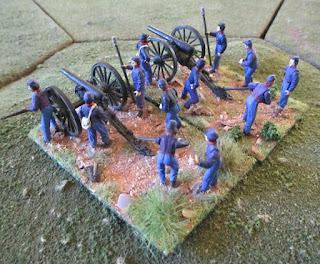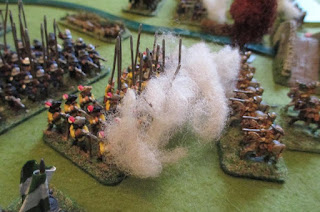A variety of images for today's post:
I have continued with my drive on painting ACW figures: artillery has been at the forefront this time, with two Union guns and a Confederate cannon from the Perry Miniatures 28mm hard plastic set.
The two models are a 12pdr Parrott on the left of the camera and a 3" Ordnance on the right.
I did the gunners in different blues - Oxford Blue and Dark Prussian Blue for the jackets, with Flat Blue or Dark Blue for the trousers. The guns, from what I could discover online, were an Olive Drab style, with Black for any metal areas.
I did the gunner nearest the camera holding a rifle as if to suggest he was ready to fend off any nearby hostile skirmishers.
The Confederate gun is a 12pdr Napoleon. Various greys and browns for the uniforms, while the gun I did in a dark wood style, there seems to be some debate about whether Confederate pieces had a particular colour.
A gun team for my Napoleonic "imagi-nation" Arcadia.
Some more Confederate infantry.
The flags are by GMB, kindly given to me by my regular opponent, Steve.
Two companies forward as skirmishers, the rest of the regiment in support.
Another Napoleonic "imagi-nation" unit - the Musketeer Infantry Regiment No.9
of the Kingdom of Nemea.
And finally, below, a few images from a Napoleonic game I fought with Steve today. All the figures are his, French, Austrian, British and Spanish, various manufacturers and beautifully painted and based by Steve. We wanted to try out the Shako 2 rules so it is an imaginary scenario, with a Franco-Spanish force vs. an Austro-British one. The latter won the game after all the former's infantry broke and fled! However, the Austro-British force lost all its artillery and cavalry before that happened. It was enjoyable to play and we worked out the rules as we went along, finding some interesting anomalies, but basically learning not to attack in column against line, even in overwhelming numbers, and that the rules produce a fast-based game.



















































